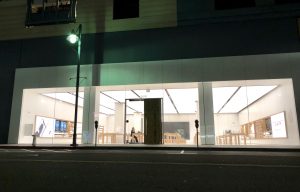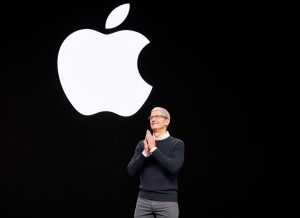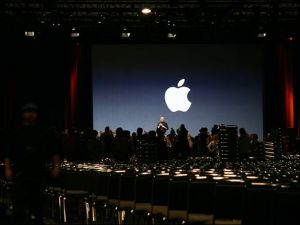Is It Recovery Mode Time For Apple And Its Leadership Due To Lack Of Innovation?
COMMENTARY: 03.29.19- Apple, Inc. has become complacent over the past decade or so and for a number of years now has lacked the innovation that the Cupertino, California-based tech giant is known and famous for which elicits the question of whether it is time for the company to have a new leader at the helm in order to start fresh and bring back what is core to its survival.
In a story published last month on Wired magazine written by Molly Wood, the contributor writes in her piece that Apple is a company on the verge of being disrupted. According to her, the next great idea in tech and consumer electronics will not materialize from within the walls of its Cupertino spaceship campus, Apple Park, and despite doing everything right, it doesn’t see the next wave of innovation coming and will ultimately… fail.

The beacon of innovation for Apple in recent years is in the major overhaul and revamped design of its retail stores. From the architecture of the storefront and the inner layout of the store, to the whole customer experience. Walk in to any Apple Store these days and it’s a totally different atmosphere compared to the original format that was envisioned more than two decades ago by the late Apple co-founder and former CEO Steve Jobs when he came up with the idea for a brick and mortar retail establishment for selling Apple products.
All of this is thanks to outgoing Apple senior Vice President of retail Angela Ahrendts who, after five years with the company, will be leaving next month in April. It was the high profile executive — one of the highest paid and the first and only female senior executive on the team to date — who was instrumental in incorporating a number of changes now commonplace in every Apple Store.
Two of those innovative and major changes — according to staff writer Michael Simon of Macworld magazine — which Ahrendts was responsible for are “Today at Apple” and Apple town squares. The first, “Today at Apple,” is a program featuring dozens of free classes in-store created to showcase the array of creative things you can do with your Apple devices and is a bridge between the real world and Apple’s retail stores. The second, where the Apple Store has been transformed into a town square format, is now more of a community meeting place that is more inviting than ever before — and less of a shopping destination — where the best of Apple comes together and everyone is welcome.
In comparison, under the leadership of Apple CEO Tim Cook — or is it “Tim Apple”, which the current President of the United States recently and erroneously referred to him as — the three products created since he took over in 2011 after the passing of Jobs, his predecessor, are devices that are low on the spectrum of the company’s greatest innovations. We saw the release of the Apple Watch in 2015, AirPods in 2016, and the HomePod in 2017 which are all products not really considered game changers or industry movers.
We need to go back almost ten years for the last time Apple unveiled a new breakthrough product designed from the ground up. In this current decade, we have seen the release of the original iPad in 2010 while in the decade before that, Apple released the original iterations of the MacBook Air in 2008, the iPhone in 2007, and the iPod in 2001, preceded in the decade prior to that with the release of the original versions of the iBook in 1999, the iMac in 1998, and finally the special limited edition Twentieth Anniversary Macintosh in 1997.
The common thread tying all of those products together is, of course, none other than Jobs himself who, after infamously being ousted from his own company in 1985, returned to the company in 1997 and would be responsible for overseeing the aforementioned product innovations — the sole exception being the Twentieth Anniversary Macintosh which was developed and created prior to his return but released nonetheless under his watch — and, not to mention, bringing Apple back to life from the brinks of impending doom. All of those new products under Jobs were examples of Apple innovation at its best. If Jobs was still alive and Apple CEO today, he surely would have spewed out innovation after innovation over the past eight years. But when he left this world, the innovation machine went with it.
Apple’s dilemma as an innovator, according to Wood — based on a book she read by author Clayton Christensen titled The Innovator’s Dilemma (where most of her piece is centered around) — is the trap that successful companies fall into time and time again. And that success, at least for Apple, is spelled: iPhone.
One example from Christensen’s book that Wood gives is a principle of good management —that you should focus investments on those innovations that promise the highest returns — which inevitably leads to the downfall of successful companies (a principle Cook appears to be following by the book, no pun intended). According to her, the bulk of Apple’s investments since 2007 when the iPHone came out has been about maintaining, developing, and selling that one device. Its success, the economic halo around it, and its seeming invincibility since its launch have propelled Apple to heights few companies ever imagined but the device will also be its undoing, she writes.
Wood explains, furthermore, what happens when a company has a product that is successful: it gets comfortable and doesn’t want to try anything new. (And, the new things it does try have to be justified in the context of its core product).
Such as Apple and its iPhone, which has become, under Cook, the driving force of the company, along with services that are closely tethered to the former breakthrough device, a 12-year old product — one that has seen only incremental updates each year, albeit some major, since its inception — which finally has lost its magic and, as a result, suffered a decline in sales.
This is where Cook seemingly appears to fail in his role as Apple CEO, stuck in a rut, sticking to the tried and true, holding onto the past, and by doing so has kept the company — as successful as it is (for a period of time last year, the company was ranked number one, valued at $1 trillion in 2018) — from innovating and moving forward into the future.

A different portrait of cook is painted by editor and publisher Leander Kahney of the website Cult of Mac who has written the first full-length biography of the Apple CEO and the book — which is titled Tim Cook: The Genius Who Took Apple To The Next Level — is due out sometime in mid April.
After all, Cook was hand picked by Jobs himself to be heir apparent and early on, according to Kahney, was Jobs’s right hand man — a de facto CEO, running Apple behind the scenes allowing the Apple co-founder to concentrate on what he liked to do best which was helping develop new products (keyword: innovation) — but the author of the upcoming book feels that the chief executive officer is underrated and that the narrative of Cook riding the coat tails of his predecessor is not true and needs to change, describing the CEO as his own man, transforming Apple in his own way.
Kahney believes that Cook is doing almost everything right — even writing that some pundits (he spoke to one, to be exact) are beginning to argue that he is Apple’s best CEO yet — and the company today is a better corporate citizen than it was in the past and as a business is firing on all cylinders.
And, on the big question of whether Cook can innovate, the editor and publisher gives a resounding… “yes.”
However, for a company like Apple where innovation drives it to its core (again, no pun intended), you can argue that Cook hasn’t done much in that arena and its absence speaks volumes, what with the lack of any new breakthrough products out of the pipeline ever since he became its CEO eight years ago. We haven’t had any mind blowing devices or innovations since the untimely death of Jobs.
Just take a look at what Apple unveiled earlier this week at the “Showtime” special event on Monday — Apple TV+, a new streaming video subscription service — or the announcements of new products from last week which were modest at best and all existing hardware and accessories in its pipeline. The latter is a perfect example of how the company doesn’t have any new ideas, simply choosing to take things from the past (e.g., the iPad Air or iPad mini) and bumping up its specs, while the former, along with the other two products unveiled on Monday (e.g., the new Apple Arcade or Apple News+), is a prime example of Apple’s new business model of becoming a company focused on services and earning revenue from it.
Granted, and to be fair, Cook has kept the company afloat during his tenure as its CEO but, for him, the white elephant in the room, so to speak, is… innovation.
Is it time for Apple to go into recovery mode and have a new leader at its helm in order to become, again, the innovation machine that it once was?
One drastic option Apple could take is to search for a new CEO from outside its walls. For instance, Tesla co-founder and CEO Elon Musk, as suggested by Geoffrey James, contributing editor of inc.com — the website of Inc. magazine — who views Tesla under Musk as the exact opposite of Apple under Cook and the former of the two CEOs, if anything, creates too much innovation, often too quickly.
James is sure that he is not the first person to notice that Musk has inherited the mantle that Jobs once wore as avatar of the power of technology to change the world for the better. According to him, on one hand you have a rich company with Apple that can’t innovate because it lacks a visionary, while on the other hand, you have a cash strapped company with Tesla that innovates like Apple under Jobs but on mega-steroids.
The contributing editor points out rather bluntly that it’s no big secret that Apple under Cook has been an innovation dud and the company hasn’t created a new platform or device (with the exception of the Apple Watch which he describes as “meh”).
The simple and obvious solution James dreams up — but knows will never happen — is for Apple to acquire Tesla and make Musk its CEO which would lead to us, in his own words, living in the freakin’ world of tomorrow by 2025.
The other option on the table and the most logical one for Apple to take is to search for a new CEO within its own ranks. As technology reporter Mark Gurman of the business news site Bloomberg reports, Apple has a deep bench of experienced managers who could fill Cook’s shoes when the time comes, the company’s leadership team consisting of ten executives other than the chief executive officer.
Such as Apple veterans like chief operating officer (COO) Jeff Williams, senior Vice President of worldwide marketing Phil Schiller,, senior Vice President of internet software and services Eddie Cue, senior Vice President of hardware engineering Dan Riccio, and senior Vice President of software engineering Craig Federighi, just to name a few.
Or newcomers like chief financial officer (CFO) Luca Maestri and the aforementioned Ahrendts who was rumored — before she announced her upcoming departure back in February of this year — to be on the shortlist of people to be one of the possible successors to replace Cook.
Interestingly enough, Cook already has succession on his mind. According to Gurman, while addressing the subject at an annual company shareholder meeting in February of last year, the Apple CEO said that eventually passing the baton properly was one of his most important roles.
However, Gurman stresses that there’s no reason to believe that Cook is planning to step down anytime soon and considering how far off his departure may be, it’s possible a successor isn’t yet even on the executive team.
Wood of Wired magazine makes a great point in that the people in charge at Apple are the same people that have been in charge for decades. Cook, Cue, Schiller, Federighi, and Apple chief design officer Jony Ive — who, surprisingly, was not on Gurman’s list of Apple veterans (and role-wise has been said to be the new Steve Jobs) — are all high profile executives who have been with the company since the late 1980s or 1990s and are a brilliant team with a long record of execution and unparalleled success, but, without a lot of fresh ideas.
It’s definitely a dilemma for an innovator like Apple. Cupertino (Houston), we have a problem. And, a huge one at that. According to James of inc.com, even Apple’s management knows they’ve lost the edge because the interest on the billions of dollars of cash that the tech giant has in the bank appears to be a better investment than innovating with new product development.

So, what is an innovative company, such as a tech giant like Apple, to do to solve this conundrum its run into?
To turn things around — in the interim while Cook is still (or remains) Apple CEO or whoever eventually becomes his successor (whether sooner or later) — Apple can, ironically, look to the past and take a page out of the playbook of its late co-founder and former chief executive officer: Steve Jobs.
Wood suggests in her piece that the final option for innovation is one that Apple has availed itself of many times in the past, which is, to find the hottest thing in tech that is still slightly unknown and come out with a better version of its own. She gives such notable examples of Apple innovations as the Mac OS and the computer mouse, which both were developed to maturity (with permission, as Wood notes) after being invented at Xerox PARC; the iPod, which was born of existing MP3 music players; and — of course! — the iPhone, which improved on clunky and ugly smartphones already on the market.
As Jobs liked to often say, according to Wood, quoting Picasso, “Good artist copy, great artists steal.”
